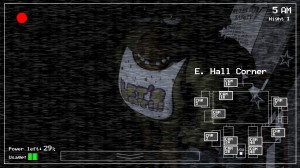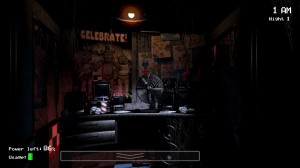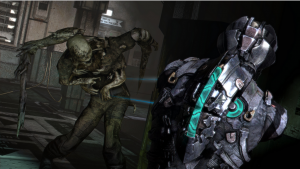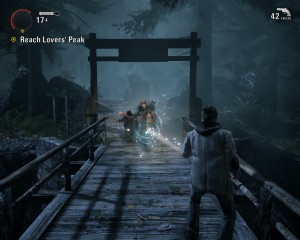The Five Nights at Freddy’s series has been very interesting to track the evolution of. I already talked about the first game a few months ago, but in about a year there have been three other titles with varying difficulties and design.
As I’ve watched footage of the other three games and seeing how far the design has come, I think my opinion of the series has remained the same: It’s an amazing take at horror, but a poor example of game design.
(Note: There will be some spoilers to the FNAF series in this post, but nothing discussing the exact endings or plot of any of the games)
Before we talk about what I just said, I want to look a little deeper at why the series has become so popular over the span of a year.
1. Distilled Horror:
There are two big issues with creating horror either in a video game or in any other medium. The first is that it’s very hard to sustain a horror situation; the player will become accustomed to the gameplay and each game becomes less and less interesting. Or the writer attempts to flesh things out across multiple iterations and in doing so, makes the series as a whole boring as they try to tie everything up in a big bow.
Five Nights at Freddy’s gets around these two issues brilliantly in my opinion, thanks to developer Scott Cawthon’s willingness to keep changing things around. From a narrative perspective, each game may follow the same basic DNA, but the situation itself is different. Without spoiling things too far, each game does in fact take place at different time periods within the franchise’s history.

To its credit, each game in the series has different takes on the design which prevents them from becoming repetitive
And because of that, each game has subtle and not so subtle changes to the gameplay. The original Five Nights at Freddy’s was all about controlling power and visual cues, while later games in the series made it about sound and other things to manage.
This means every game basically starts the player back at 0 in terms of understanding what’s going on; a huge deal for sustaining and growing horror. Just because someone masters the first game, doesn’t mean they can enter #4 confident about how things work; a far cry from any other horror series on the market.
Each individual game is not a long experience and most people should be able to beat them in a few hours of play (not counting advanced challenges, but we’ll come back to that.) Again, by keeping each game short and varied, Five Nights at Freddy’s avoids the classic trap of over explaining or getting stuck in a rut. Next, let’s talk about the aesthetic design and how the series has done a lot with very little.
2. Unified Aesthetic:
Five Nights at Freddy’s is not a graphically intensive series nor is it that complicated. The series makes heavy use of pre canned animations and one main screen without any greater control of exploration on the player’s side. To compensate, the environmental design and overall aesthetics of the game are some of the best I’ve seen from the genre.

The use of sound and lighting have helped to create an oppressive environment and elevate the basic animations and play
Random sounds and the explicit use of blind spots and darkness, help to create a claustrophobic situation that the player feels trapped in.
While the various robots “move” via a prearrange set of animations, their designs are noticeably distinct. Each game in the series has improved on the models while keeping their basic designs.
As a result, the characters of Bonnie, Chicka, Foxy and of course Freddy have become cemented in the playerbase’s mind. These four characters are now just as recognizable as horror movie characters and is why there has already been a movie deal to license them.
Our next point is a quick one and it has to do with the series becoming tied to YouTube.
3. Streamer Success:
If there is one series that has encapsulated the YouTube phenomenon of watching streamers play games, it’s Five Nights at Freddy’s. Horror is already a great genre for watching with a group, as the terror can become magnified with everyone screaming at once. With Five Nights at Freddy’s, you can get a complete experience watching someone play the game and celebrate their victories or scream along with them when they fail.
And everyone who watches these streamers tells their friends which helped to raise awareness of the series and has been instrumental in the rise of the series’ popularity. For our final point on what the series did right, we’re going to talk about the bigger picture.
4. The Big Mystery:
As I said in point one, the series has avoided the stumbling block of other horror series thanks to changing the formula and situation with each game, but there is more to it than that. The Five Nights at Freddy’s series has a lot of hidden secrets that helped to expand the overall story.
First is despite the title of the game, each game has six days to explore with usually some kind of reveal saved for the last. For players who want more, each game features a super hard mode called “20/20 mode.” Basically this mode sets the difficulty and frequency of each character’s AI to the max and challenges the player to beat it.

The big differing point between Five Night’s and other horror series, is the fact that the player is a passive participant instead of being active
In most games, the super hard mode is simply left as an optional challenge with no in game benefits or greater meaning to it, but Five Nights at Freddy’s is different.
Players who have managed to beat the 20/20 mode will find additional story elements revealed.
Over the course of the four games, there has been a mystery regarding what set the animatronics off, the events that closed the restaurant and the back-story regarding some of the major players in the series. There have been so many discussions about the plot, both through posts and videos with people trying to piece it all together. And again, all this interest helps spread awareness of the series and has helped it achieved its cult status.
So far I’ve spent just about 1,000 words talking about how great Five Nights at Freddy’s is, but it’s time to talk about the killer (no pun intended) issue of why the series doesn’t work for me from a design point of view.
A Haunted House:
Five Nights at Freddy’s has all the elements needed to create a great horror experience, but it doesn’t really work from a horror game’s perspective. The actual playing of the game is based around a very limited set of mechanics and interactions.
Each game is about you responding to the threats around you which is a passive experience. More importantly, because the player is not directly interacting with the game, it means that there is really one correct way to play the game.
While each game is different in terms of situations and mechanics, their actual use is limited; once you know how a jump scare works, it’s going to work the same time, every time, like clockwork. You’re not really playing the game in the sense of being challenged against an AI or situation, but following a set of if/then conditional statements.
A major part of what makes a horror game work, is forcing the player into a tough situation; this could be anything from fighting a monster in Dead Space, to running from a creature like Pyramid Head in Silent Hill 2. The point is that the player is the one who is engaged and engaging the mechanics and situation. There is a classic example that I go to when talking about this: Evil Dead 2.

A great horror game experience requires a constant push and pull between making the player feel powerful and powerless; something that Five Night’s is lacking
In Evil Dead 2, there is a scene near the end when Ash has to go into the cellar armed with a chainsaw and double barrel shotgun.
This is the heaviest armed he has been in the entire movie and he is still visibly scared to death, because he has to be the one who engages in the situation.
If the scene was him waiting for the deadite to pop up so that he could shoot it, the entire dynamic would have been different.
Five Nights at Freddy’s despite all the aesthetics, the big mystery and constantly changing situation, is still just a passive experience and walks that line between being interactive and just a set of commands for the player to follow. This is why I am interested to see what they do with a movie based on the game, where a director can focus on the tension and pacing instead of a player.
Renovation:
Despite what I’ve said, that hasn’t stopped Five Nights at Freddy’s from becoming a cult favorite from the Indie market. With #4, this is supposedly the last game in the storyline so far; what that means for the future is anybodies’ guess. If developer Scott Cawthon can take the same eye to aesthetics and storytelling and apply it to a new set of mechanics, we could have one truly terrifying franchise.


